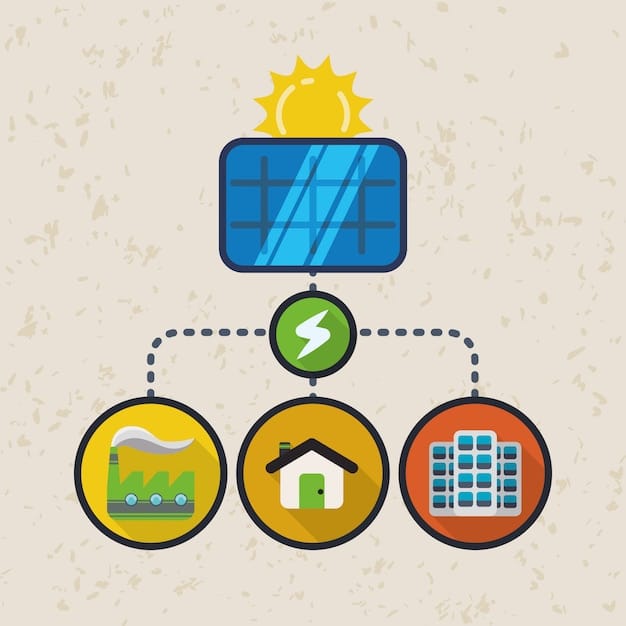Solar Panel Efficiency Breakthroughs: Maximize Your Savings in 2025

Solar panel efficiency breakthroughs are revolutionizing energy production, offering homeowners and businesses in the US significantly increased energy output and potential long-term savings on electricity bills.
Discover how solar panel efficiency breakthroughs are transforming the energy landscape, unlocking higher energy yields and bigger savings for consumers across the United States.
Understanding Solar Panel Efficiency
Solar panel efficiency is a crucial factor in determining the overall performance and economic viability of a solar power system. It essentially defines how effectively a solar panel can convert sunlight into usable electricity.
Higher efficiency ratings translate to increased power generation from the same amount of sunlight, allowing homeowners and businesses to maximize their energy savings and reduce their reliance on traditional energy sources.
What is Solar Panel Efficiency?
Solar panel efficiency is the ratio of electricity generated by a solar panel to the sunlight that hits its surface. It is expressed as a percentage, indicating the amount of sunlight converted into electricity.
For example, a solar panel with an efficiency rating of 20% will convert 20% of the sunlight it receives into electricity, while the remaining 80% is either reflected or converted into heat.
Why is Efficiency Important?
Efficiency is important because it determines how much electricity you can generate from a given area. Higher efficiency panels produce more power per square foot, which is especially beneficial for homeowners with limited roof space.
- Maximizes Energy Production: Higher efficiency panels generate more electricity, leading to greater energy savings.
- Reduces System Size: Allows for a smaller system size to achieve the same energy output, lowering installation costs.
- Increases Property Value: Solar panels can increase property value, and higher efficiency panels are even more attractive to potential buyers.
In conclusion, understanding solar panel efficiency is crucial for making informed decisions about investing in solar energy. Higher efficiency panels offer significant advantages, allowing you to maximize energy production, reduce system size, and increase your return on investment.

Recent Breakthroughs in Solar Panel Technology
The solar energy industry is constantly evolving, driven by relentless research and innovation. Recent years have witnessed remarkable breakthroughs in solar panel technology that have significantly improved efficiency and performance.
These advancements have not only made solar energy more accessible to a wider range of consumers but have also paved the way for a more sustainable and affordable energy future.
Perovskite Solar Cells
Perovskite solar cells are a relatively new technology that has shown tremendous potential for achieving high efficiencies at a lower cost compared to traditional silicon-based solar cells.
These cells utilize a perovskite-structured compound as the light-harvesting active layer, offering advantages such as high power conversion efficiency, ease of manufacturing, and flexibility.
Bifacial Solar Panels
Bifacial solar panels are designed to capture sunlight from both the front and back sides, increasing energy production compared to traditional monofacial panels. This technology is particularly effective in environments with highly reflective surfaces.
By harnessing sunlight reflected from the ground or surrounding structures, bifacial panels can generate up to 30% more electricity, maximizing energy savings and improving the overall return on investment.
Quantum Dot Solar Cells
Quantum dot solar cells utilize nanoscale semiconductor particles to absorb sunlight and convert it into electricity. These cells offer the potential for high efficiencies, low manufacturing costs, and tunable absorption spectra.
- Improved Light Absorption: Quantum dots can be engineered to absorb a wide range of sunlight, increasing energy production.
- Enhanced Efficiency: Quantum dot solar cells have demonstrated promising efficiency levels in laboratory settings.
- Reduced Manufacturing Costs: The manufacturing process for quantum dot solar cells is potentially simpler and more cost-effective than traditional silicon-based cells.
In summary, recent breakthroughs in solar panel technology, such as perovskite, bifacial, and quantum dot solar cells, are significantly improving efficiency and performance. These advancements are unlocking new possibilities for solar energy, paving the way for a more sustainable and affordable energy future.
The Impact of Efficiency on Your Energy Savings
The efficiency of your solar panels directly impacts your energy savings. Higher efficiency means more electricity generated from the same amount of sunlight, leading to greater reductions in your electricity bills.
Understanding how efficiency affects your savings is crucial for making informed decisions about choosing the right solar panel system for your needs and maximizing your return on investment.
Calculating Your Potential Savings
To calculate your potential savings, consider the efficiency rating, panel size, and sunlight exposure in your area. Higher efficiency panels require less space to generate the same amount of electricity, saving on installation costs.
By estimating your energy consumption and factoring in the efficiency of your solar panels, you can determine the size of the system needed to meet your energy needs and calculate your potential savings over time.
Factors Affecting Real-World Efficiency
Real-world efficiency can be affected by factors such as temperature, shading, and panel degradation. High temperatures can reduce panel efficiency, while shading can significantly decrease energy production.
Regular maintenance and cleaning can help mitigate these effects, ensuring your panels operate at their optimal efficiency and maximize your energy savings.
Long-Term Cost Benefits
Investing in high-efficiency solar panels offers long-term cost benefits. While the initial investment may be higher, the increased energy production and reduced electricity bills will result in greater savings over the lifespan of the system.
- Reduced Electricity Bills: Higher efficiency panels generate more electricity, lowering your monthly electricity bills.
- Increased Return on Investment: The long-term savings from reduced electricity bills offset the initial investment, increasing your return on investment.
- Environmental Benefits: Solar energy reduces your carbon footprint and promotes a more sustainable environment.
In conclusion, the efficiency of your solar panels has a direct impact on your energy savings. By understanding the factors that affect efficiency and investing in high-quality panels, you can maximize your savings and enjoy the long-term benefits of solar energy.

Choosing the Right High-Efficiency Solar Panels
Selecting the right high-efficiency solar panels requires careful consideration of your energy needs, budget, and environmental conditions. Factors like panel technology, warranty, and installer reputation play crucial roles in the selection process.
By evaluating your specific requirements and researching available options, you can make an informed decision and choose the solar panels that best suit your needs and maximize your investment.
Considerations for Panel Selection
When selecting high-efficiency solar panels, consider factors such as the panel’s efficiency rating, temperature coefficient, and degradation rate. Lower temperature coefficients indicate better performance in hot climates, while lower degradation rates ensure long-term energy production.
Additionally, evaluate the panel’s warranty coverage, ensuring it protects against defects and performance decline over the lifespan of the system.
Comparing Different Panel Technologies
Different solar panel technologies, such as silicon-based, perovskite, and thin-film panels, offer varying levels of efficiency, cost, and durability. Silicon-based panels are the most common type, known for their reliability and longevity.
Perovskite and thin-film panels are newer technologies that offer the potential for higher efficiencies and lower costs, but may have shorter lifespans or require specialized installation.
Working with Qualified Installers
Partnering with a qualified and experienced solar panel installer is essential for ensuring proper system design, installation, and maintenance. A reputable installer can assess your energy needs, recommend the best solar panel system for your requirements, and provide ongoing support.
- Proper System Design: Installers design systems to maximize energy production.
- Professional Installation: They ensure panels are installed correctly and safely, optimizing performance and longevity.
- Ongoing Support: Reputable installers offer maintenance and support to ensure your system operates efficiently.
In summary, choosing the right high-efficiency solar panels involves careful consideration of your energy needs, budget, and environmental conditions. By evaluating different panel technologies, working with qualified installers, and understanding the factors that affect performance, you can make an informed decision and maximize your investment in solar energy.
Financing Options and Incentives for Solar Panels
Financing options and incentives can significantly reduce the upfront costs of solar panel installations, making solar energy more accessible and affordable for a wider range of consumers. Understanding available financing programs and incentives is crucial for maximizing your return on investment and making solar energy a financially viable option.
Several government incentives, tax credits, and financing programs are available to help offset the cost of solar panel systems.
Federal Tax Credits
The federal government offers a significant tax credit for homeowners and businesses that install solar panel systems. This tax credit can cover a substantial portion of the system’s cost, reducing your overall investment.
Consult with a tax professional to determine your eligibility and claim the credit when filing your taxes.
State and Local Incentives
Many states and local governments offer additional incentives for solar panel installations, such as rebates, grants, and tax exemptions. These incentives can further reduce the cost of your solar system and improve its financial viability.
Research available incentives in your area and take advantage of these programs to maximize your savings.
Loan Programs and Financing Options
Various loan programs and financing options are available to help you finance your solar panel installation. These options include secured loans, unsecured loans, and power purchase agreements (PPAs).
- Secured Loans: Use your home as collateral for a lower interest rate.
- Unsecured Loans: Don’t require collateral but may have higher interest rates.
- Power Purchase Agreements (PPAs): Allow you to purchase electricity generated by the solar panels without owning the system.
In conclusion, financing options and incentives can play a significant role in making solar energy more affordable and accessible. By exploring available programs and choosing the right financing option, you can reduce the upfront costs of solar panel installations and maximize your return on investment.
Future Trends in Solar Panel Efficiency
The future of solar panel efficiency is bright, with ongoing research and development paving the way for even more efficient and cost-effective solar energy solutions. Emerging technologies, such as advanced materials and innovative designs, promise to further enhance solar panel performance and expand the adoption of solar energy worldwide.
Continued advancements in materials science and engineering are driving rapid improvements in solar panel technology.
Next-Generation Solar Cells
Researchers are actively developing next-generation solar cells that offer the potential for significantly higher efficiencies compared to traditional silicon-based cells. These technologies include multi-junction cells, perovskite-based cells, and quantum dot cells.
Multi-junction cells, for example, combine multiple layers of different semiconductor materials to capture a wider range of sunlight and convert it into electricity more efficiently.
Smart Solar Panels
Smart solar panels incorporate advanced sensors and communication technologies to optimize performance and monitor system health in real time. These panels can adjust their orientation to track the sun’s movement, maximizing energy production throughout the day.
Additionally, smart panels can detect and diagnose performance issues, allowing for proactive maintenance and ensuring optimal system efficiency.
Integrated Solar Solutions
Integrated solar solutions, such as building-integrated photovoltaics (BIPV), seamlessly incorporate solar panels into building materials, transforming surfaces like roofs, facades, and windows into energy-generating assets.
- Aesthetic Appeal: BIPV can enhance the aesthetic appeal of buildings while generating clean energy.
- Cost Savings: Reduces the need for separate solar panel installations, lowering costs.
- Sustainable Design: Promotes sustainable building design and reduces environmental impact.
In summary, the future of solar panel efficiency is promising, with emerging technologies and innovative designs driving continued improvements in performance and cost-effectiveness. As solar panel technology evolves, solar energy will play an increasingly important role in meeting the world’s growing energy needs and creating a more sustainable future.
| Key Aspect | Brief Description |
|---|---|
| 💡 Efficiency Defined | The ratio of sunlight converted to electricity, impacting savings. |
| 🔬 Tech Advances | Perovskite, bifacial, and quantum dot cells enhance performance. |
| 💰 Savings Impact | Higher efficiency leads to greater energy production and lower bills. |
| ☀️ Future Trends | Next-gen cells, smart panels, and integrated solutions are emerging. |
FAQ
▼
The average efficiency of modern solar panels ranges from 15% to 22%, with some high-end panels exceeding 22%. Efficiency depends on the panel technology and manufacturing quality.
▼
High temperatures can reduce solar panel efficiency. Most panels have a temperature coefficient indicating the percentage decrease in efficiency per degree Celsius above 25°C.
▼
Bifacial solar panels capture sunlight from both sides, increasing energy production. They are effective in environments with reflective surfaces like snow or light-colored roofs.
▼
Yes, higher efficiency solar panels can be worth the investment, especially if you have limited roof space. They generate more electricity, leading to greater savings over time.
▼
Solar panels typically require minimal maintenance. Regular cleaning to remove dirt and debris can help maintain optimal efficiency. An annual inspection is recommended to check for any issues.
Conclusion
As solar panel efficiency breakthroughs continue to reshape the energy landscape, homeowners and businesses in the US can look forward to increased energy savings and a more sustainable future. By understanding the latest advancements, choosing the right panels, and taking advantage of available incentives, you can harness the power of the sun to reduce your carbon footprint and secure a brighter energy future.





